A couple of weeks ago, I Skyped with my 97-year-old grandmother back in the U.S. because I was not happy with the results of my stuffed cabbage rolls over the years. I wanted to know what was missing; I wanted to nail it this Christmas. After discussing all my attempts (she actually bought a head of cabbage for the purpose, and was prepared to cook the darned things with me over Skype), I got to the part where we make the sauce.
I told her that I usually prepare a tomato sauce like I would for spaghetti and she looked positively miffed. “What are you making? Italian cabbage rolls or Ukrainian cabbage rolls? Who makes spaghetti sauce for Ukrainian cabbage rolls?”
She then proceeds to tell me that the two key ingredients for her tomato sauce are ketchup (?!?!) and sour cream! As a Ukrainian descendant, I should have known the sour cream part. The ketchup was just hilarious. And she went on, “Then I put the whole mess in the casserole dish and put a stick of butter on top before putting it in the oven.” Well, there you go. Now I knew for certain that my problem was the lack of dairy and fat.
Some of you have written to me about the foods I describe in my novels. You know how the question usually comes up, “How much of you, the author, are in these stories?” Food fanaticism is certainly a key ingredient to my writing. I love food, I love cooking and I really, really love discovering the foods of different cultures. So, I’ve put a little Christmas twist on this month’s blog and focused on the foods around Christmastime in the three regions my novels take place: Northern Italy, the former Czechoslovakia, and Ukraine. Enjoy!

South Tyrol, Northern Italy
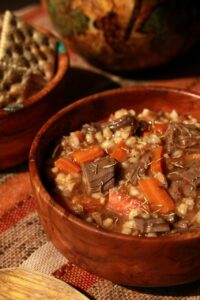
Barley Soup
Christmas Begins with Advent...
Loads of cooking happens in the Reschen Valley series, mostly because my character, Jutta Hanny, runs an inn. And simply because food is a central part of our lives, no?
So, how is Christmas celebrated in South Tyrol? In the run-up to Christmas, the families gather around the Advent wreath on Sunday. The first big highlight of Advent are the Krampus processions around December 5. The Krampuses with their shaggy fur capes, rattling chains, grotesque masks and loud bells don’t only scare children, they scared the living daylights out of me in Salzburg one year when my mother and I ran across one in a dark cobblestoned alley. It took me a few minutes to recover.
Usually, Krampus accompanies St. Nicholas, who presents the good children with sweets. The first Sunday of Advent is also the official Christmas market opening. Glühwein (mulled wine) and roasted chestnuts are the big highlights. On the morning of December 24, people get together, discuss the preparations and buy the last ingredients for the Christmas menu. Families attend the Children’s Mass in the afternoon, others attend the Midnight Mass. Presents are not brought by Santa Claus in this culture but by the Christ Child. In the evening, the family has its meal but the Christmas tree is closed off in a separate room. When the bell rings, the children know that the Christ Child has brought the presents and they charge into the room where the tree is lit up (some families still use real candles).
Traditionally, the Christmas eve meal is a simple fare. It’s Christmas day that sees the big feast table.
Barley Soup
I’m sharing one of my favorite soups with you. It’s hearty and delicious and easy to make. Speck is something that is very regional but you may substitute thick-cut bacon or pancetta (recommended).
Apple Strudel
is the classic dessert, and not only for Christmas. In most restaurants, you can order it with ice cream, whipped cream or hot vanilla sauce (like a runny pudding). And you can mix up that apple filling with walnuts, raisins, whatever you like, really.

Former Czechoslovakia
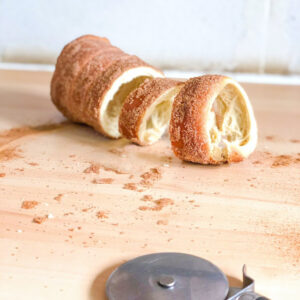
Trdelniki
The Golden Pig Takes the Table
For many, December 24 (Štědrý den) is the most enjoyable day of Christmas holidays. Its Czech name literally means “Generous Day”, probably for the wealth of food that has traditionally been served for Christmas dinner and fed to household and farm animals. Even poor families would make sure that their plates were full on this one day of the year.
Dinner is served after sunset (traditionally, it should not be served until after the first star has come out) and consists of carp and potato salad, sometimes preceded by mushroom, sauerkraut or fish soup. Christmas carp is specially raised in manmade ponds and then sold from large tubs placed on the streets and town squares a few days before Christmas. Christmas Eve is associated with many superstitions that usually relate to life, love, and destiny that awaits one in the year to come, Some people fast during Christmas Eve in the hope that they will see a vision of ‘the golden pig‘ appear on the wall before dinner! This is meant to be a sign of good luck!
The Christmas tree is decorated with traditional Czech Christmas ornaments in many households and preparations are made for the most festive dinner of the year. As in South Tyrol, the presents are opened after Christmas Eve dinner and children are told that the gifts themselves are brought by the Baby Jesus – Ježíšek. Nobody can get up from the table until everything has been eaten and the bell carried by Baby Jesus is rung. Then everybody gets up to together at the same time. Afterward, traditional cookies and baked goods are served.
These pastries were something I saw in the window of what turned out to be my favorite bakery in Litomerice, where The Girl in the Mountains takes place. I immediately added them to my description. They are cinnamon and nut pastries, light and flaky. Delicious with a hot cup of coffee.
In one of the first scenes where Magda arrives at Villa Liška to work, the cook serves the staff a kielbasa soup. This is another one of winter’s comfort foods, and again easy to make. When people ask me if I miss anything from home, I think back on Northeast Minneapolis, with its eclectic shops where you can buy specialty cheeses, bagels, and Ukrainian sausages all within one block of one another.

Ukraine
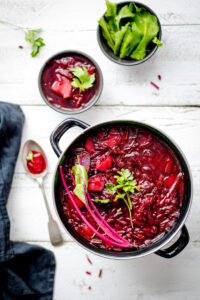
Meatless Borscht
We Celebrate Christmas Twice
Ukrainians celebrate Christmas on January 6 and 7, following the Julian Calendar. I grew up in a mixed Byzantine Catholic and Orthodox Christian family, so my brother and I grew up with two Christmases each year.
Christmas Eve is the most important day of the holiday. On Christmas Eve itself, one must maintain a strict fast of no meat, and dairy products and, if possible, not eat or drink. In the evening there is a Vesper Service in all the Orthodox churches. After the service, families get together for the main meal. You cannot start eating until the first star is seen in the sky – representing that Jesus has been born, so Christmas can start! The table is set with the best linens and china, and a sheaf of wheat tied with a ribbon (didukh), along with a bread known as kolach. Ukrainians believe that the departed family members join the family for Christmas, so an extra place is set for them. This is something I still do at our house, and you must put a little from your plate onto the extra plate for the souls.
The main Christmas meal, called ‘Sviata Vecheria’ (or Holy Supper) consists of 12 dishes that represent Jesus’ 12 disciples. The dishes have no meat, eggs or diary in them. Every dish in the meal has a symbolic meaning.
The first dish is kutia, a type of sweet porridge made of wheat mixed with poppy seeds, honey, nuts, and raisins; borscht or kapusniak which is a beet soup served with mushroom dumplings or a sauerkraut soup; fish or herring which can be fixed in different ways; holubtsi (cabbage rolls) with rice and mushrooms; vinaigrette, a vegetable dish cooked from boiled potatoes, beets, carrots, beans and peas (my family’s favorite; varenyky, filled dumplings with potato or sauerkraut or (my personal favorite) tart cherries, pyrizhky, rolls filled with bean or sauerkraut filling; potato pancakes; uzvar, which is a compote made of dried fruit and pampushky, donuts with garlic basting or rose jam filling.
Holubtsi – stuffed cabbage rolls
This is such an easy meal to make and very filling. You can make this with ground meat, but because my husband’s kids are vegetarians, I cook this with brown rice or barley and mix in tons of chopped vegetables like carrots, mushrooms, maybe spinach, fennel, onions, etc. Taste your filling; if it’s flavourful, fill those cabbage leaves!
Here’s the tip from my 97-year-old grandmother: the sauce should be made of a little bit of beef stock, tomato juice, sour cream and ketchup, all mixed up. You can make it thicker or thinner, but when reheating, add a little more juice. And before you put it all into the oven to bake, loads of butter on top… But if you prefer to have recipes for sauces, here they are.
As with the holubtsi, when I started making my own borscht, I cooked from memory. Since then, I have adapted my own recipe but never really written it down. So, each year, it’s a little different. This is one of the most delicious, most nourishing soups I know. I never make it with meat but love adding kidney beans. Beets are my happy fruit; they give me a much-needed kick of iron and I always feel better afterwards.



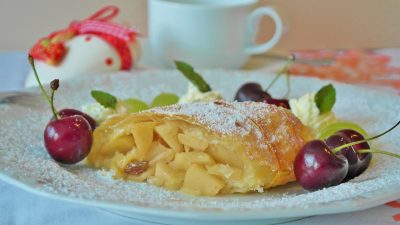

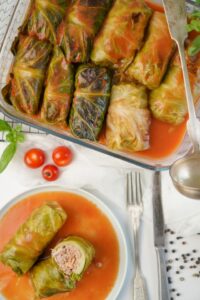
Linda Tucker
November 19, 2022 - 12:58 pm ·I loved reading about these traditions and foods. I have always found other customs to be interesting after studying them in 6th grade.
Chrystyna
January 21, 2023 - 1:42 pm ·Thank you so much, Linda. We JUST had some Ukrainian food for lunch today. Really fun.